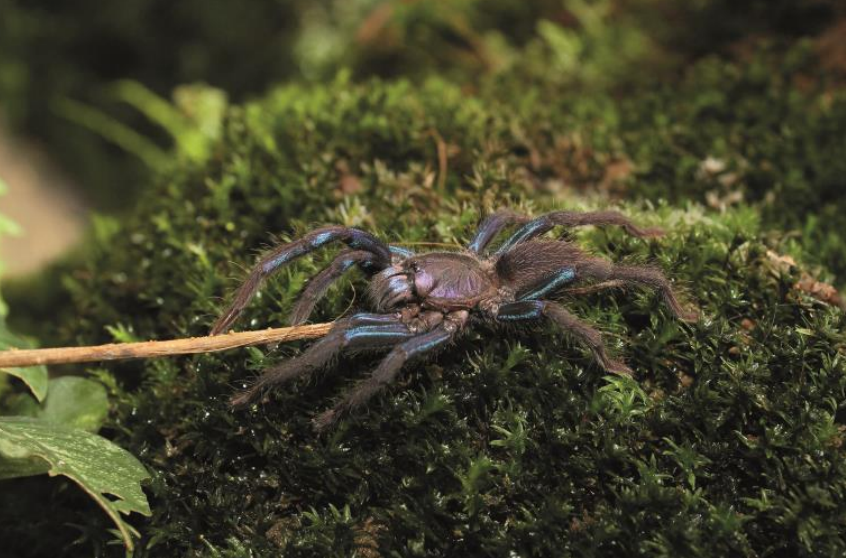Turquoise-Tinted Tarantula Discovered in Sri Lanka
The species is only the second member of its genus ever found in the South Asian country
/https://tf-cmsv2-smithsonianmag-media.s3.amazonaws.com/filer/a3/b5/a3b5539e-9d06-4251-aaec-1b224dbb512d/3d6dfe50-c5d7-11e9-bc67-220a39a7b0a2.png)
Most members of the Chilobrachys spider genus have muted brown, black or grey coloring. But Chilobrachys jonitriantisvansicklei—a newly described tarantula native to Sri Lanka—defies this trend. As a trio of researchers reports in the British Tarantula Society Journal, females of the species boast brilliant blue coloring on their legs and an iridescent sheen on their hard outer shells and abdomens.
“When we first spotted them I was in awe, lost for words,” lead author Ranil Nanayakkara of the University of Kelaniya tells National Geographic’s Nadia Drake.
Nanayakkara and his colleagues discovered the unusually adorned arachnid in a section of Sri Lanka’s southwestern rainforest surrounded by tea and rubber plantations. The spider, named after donor and conservationist Joni Triantis Van Sickle, measures around five inches long (Drake notes that it’s “big enough to comfortably hug a donut”) and is a speedy, aggressive predator that darts out from its underground burrow when hapless insects arrive on the scene.
Compared with their showier female counterparts, male members of the species are smaller and, according to Nanayakkara, “mossy brown in color.”
Per National Geographic, C. jonitriantisvansicklei is the first new Chilobrachys species found in the South Asian country since the end of the 19th century. Previously, Sri Lanka’s only Chilobrachys representative was a brown spider called C. nitelus.
The researchers spent two years identifying physical differences between C. jonitriantisvansicklei and more than two dozen Chilobrachys species native to nearby India. Based on this analysis, they determined that the turquoise-tinted tarantula was wholly unique.
Still, Robert Raven, principal curator of arachnids at Australia’s Queensland Museum, explains to Drake, “The possibility that the new one is [actually] one of the named Indian species will eventually need to be addressed,” likely through genetic sequencing aimed at confirming the spider’s singularity and gauging its population size.

Suresh Benjamin, a researcher at Sri Lanka’s National Institute of Fundamental Studies who was not involved in the new study, points out that the blue-hued spider, as well as a similarly eye-catching tarantula described by Nanayakkara in 2013, went unnoticed for so long because scientists only recently started cataloguing the country’s arachnids. Of 593 spider species known to live on the island, 108 were discovered in the last two decades.
“Fieldwork conducted … during the last few years has shown the presence of an abundant, largely unexplored spider fauna living in the remaining forest patches of the island,” Benjamin says.
Speaking with Dilrukshi Handunnetti of Mongabay, study co-author Amila Prasanna Sumanapala of the University of Colombo says that C. jonitriantisvansicklei’s colorful exterior could make it vulnerable to illegal wildlife trade. “Tarantulas like the newly discovered species need more conservation efforts, as they are traded for their charisma,” Sumanapala tells Mongabay. “There is the thrill of keeping as domestic pets species otherwise considered dangerous.”
In February of this year, a similarly striking blue-legged tarantula made headlines after a report by Science magazine’s Yao-Hua Law alleged that the researchers who documented its discovery might have acquired specimens from private collectors lacking the proper permits. Although Peter Kirk, chairman of the British Tarantula Society and editor of the journal in which the study was published, told the New York Times’ Rachel Nuwer that he “had no reason to think due process wasn’t followed,” other scientists interviewed said the incident spoke to a wider issue: namely, “biopiracy,” or the use of natural resources without the permission of local communities.
“Scientists do collect illegally, and normally this is not a huge problem, because scientists who study cacti, for example, are a small community,” Pablo Guerrero, a botanist at Chile’s University of Concepción, told Nuwer. “But every year we have more and more scientists working around the globe, and every year species are becoming more and more endangered.”
Ensuring that specimens are harvested sustainably will allow species like C. jonitriantisvansicklei to continue proliferating in the wild, where their true role in the ecosystem can be studied for years to come.
/https://tf-cmsv2-smithsonianmag-media.s3.amazonaws.com/accounts/headshot/mellon.png)
/https://tf-cmsv2-smithsonianmag-media.s3.amazonaws.com/accounts/headshot/mellon.png)